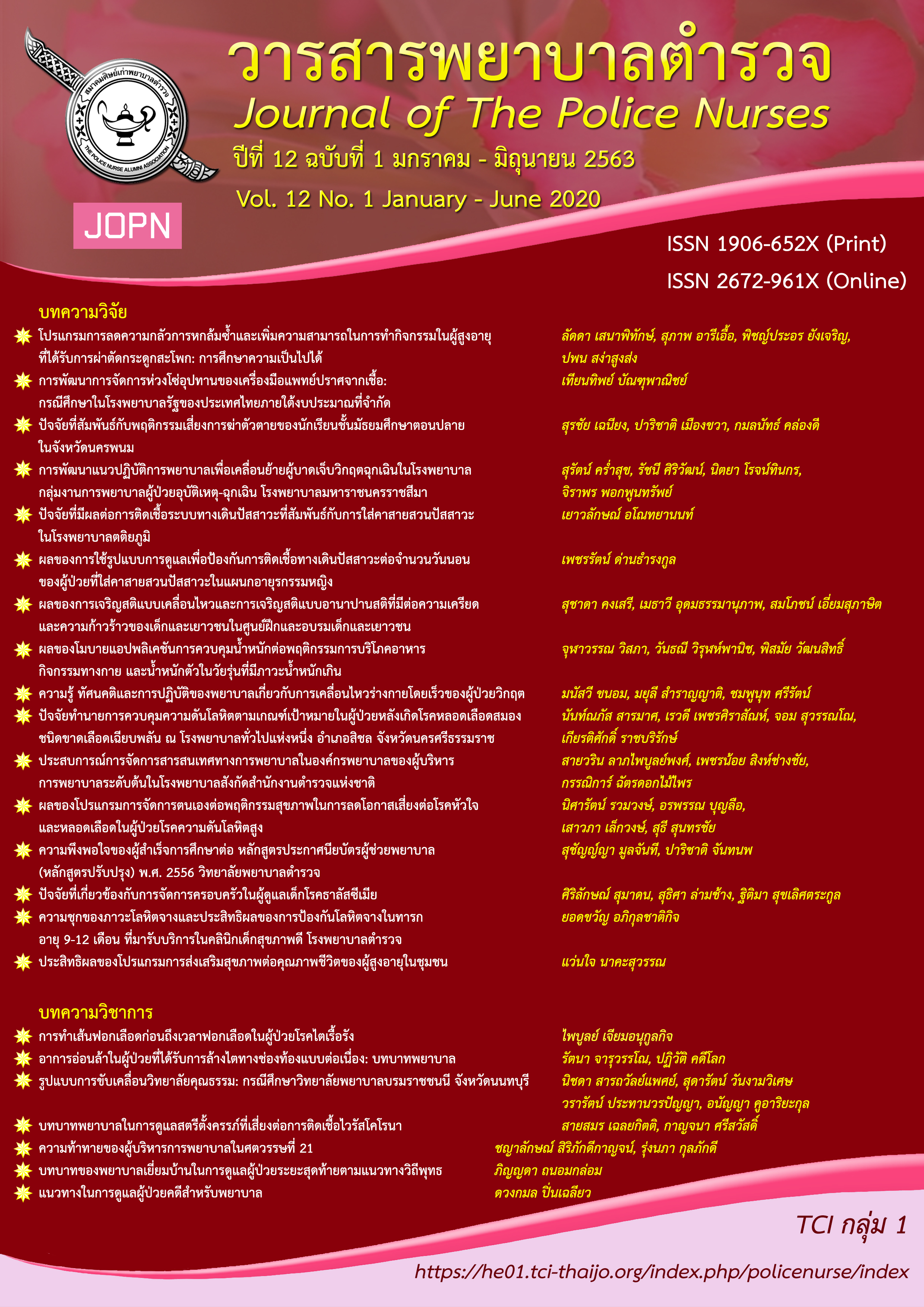โปรแกรมการลดความกลัวการหกล้มซ้ำและเพิ่มความสามารถในการทำกิจกรรมในผู้สูงอายุที่ได้รับการผ่าตัดกระดูกสะโพก: การศึกษาความเป็นไปได้
คำสำคัญ:
ความกลัวการหกล้ม, กระดูกสะโพกหัก, ผู้สูงอายุบทคัดย่อ
ความกลัวการหกล้มภายหลังการผ่าตัดกระดูกสะโพกส่งผลกระทบอย่างมากต่อภาวะสุขภาพของผู้สูงอายุหลายด้าน การวิจัยครั้งนี้มีวัตถุประสงค์เพื่อศึกษาความเป็นไปได้ในการนำโปรแกรมการทดลองที่ใช้ทฤษฎีการรับรู้สมรรถนะแห่งตนเป็นพื้นฐานไปใช้ในคลินิกเพื่อลดความกลัวการหกล้ม ลดอุบัติการณ์การหกล้มซ้ำและเพิ่มความสามารถในการทำกิจกรรมในผู้สูงอายุหลังผ่าตัดกระดูกสะโพก การศึกษาวิจัยครั้งนี้เป็นการวิจัยกึ่งทดลองแบบกลุ่มเดียววัดซ้ำ ตัวอย่าง 15 ราย ที่มีคุณสมบัติตามเกณฑ์การคัดเข้าได้รับโปรแกรมการทดลอง ประกอบด้วย การวางแผนจำหน่ายอย่างครอบคลุมและโปรแกรมการฟื้นฟูสภาพร่างกายภายหลังการผ่าตัดที่เฉพาะสำหรับแต่ละรายตามการผ่าตัดที่ได้รับ ตลอดระยะเวลาที่เข้ารับการรักษาในโรงพยาบาล วิเคราะห์ข้อมูลโดยใช้สถิติบรรยาย และสถิติทดสอบ Friedman test และ Wilcoxon signed ranks test
ผลการวิจัยพบว่า โปรแกรมการทดลองมีความเป็นไปได้ในการนำไปใช้ในคลินิกสูง (ร้อยละ 92.36) และไม่มีตัวอย่างขอถอนตัวจากการวิจัย ความกลัวการหกล้มซ้ำวันที่จำหน่ายออกจากโรงพยาบาล และหลังผ่าตัด 6 สัปดาห์ ลดลงอย่างมีนัยสำคัญทางสถิติ เมื่อเปรียบเทียบกับก่อนให้โปรแกรมการทดลอง (Z= -3.680, p = .002 และ Z = -3.352, p = .001 ตามลำดับ) ความกลัวการหกล้มซ้ำก่อนจำหน่ายออกจากโรงพยาบาลและหลังผ่าตัด 6 สัปดาห์ไม่แตกต่างกัน (Z = -1.633, p = .102) ความสามารถในการทำกิจกรรมหลังผ่าตัด 6 สัปดาห์เพิ่มขึ้นเมื่อเปรียบเทียบกับก่อนให้โปรแกรมการทดลองและวันที่จำหน่ายออกจากโรงพยาบาล (Z = -3.424, p = .001 และ Z = -3.190, p =.001 ตามลำดับ) ภายใน 6 สัปดาห์หลังผ่าตัดตัวอย่างไม่เกิดการหกล้มซ้ำ การนำทฤษฎีมาใช้เป็นพื้นฐานในการปฏิบัติการพยาบาล โดยการประยุกต์ใช้ทฤษฎีการรับรู้สมรรถนะแห่งตนมาเป็นแนวทางปฏิบัติกิจกรรมโดยตระหนักถึงบทบาทของพยาบาลเป็นสิ่งสำคัญในการส่งเสริมสุขภาพเพื่อเพิ่มความสามารถในการทำกิจกรรม และส่งเสริมคุณภาพชีวิตที่ดีของผู้สูงอายุที่ได้รับการผ่าตัดกระดูกสะโพก
Downloads
เอกสารอ้างอิง
Agency for health care research and quality advancing excellence in health care. (2018). IDEA discharge planning (Tool 1). Retrieve from https://www. ahrq.gov/sites/default/files/wysiwyg/professionals/systems/hospital/engagingfamilies/strategy4/Strat4_Tool_1_IDEAL_chklst_508.pdf
Al-Maqbali, M. A. (2014). Nursing intervention in discharge planning for elderly patients with hip fractures. International Journal of Orthopaedic and Trauma Nursing, 18(2), 68-80.
Aree-Ue, S. (2004). Feasibility and acceptability of an osteoporosis prevention program for Thai older adult in Chiang Mai (A thesisthe degree of doctor of philosophy in nursing). Graduated School, Chiang Mai University, Chiang Mai.
Aree-Ue, S., & Youngcharoen, P. (2020). Six-item cognitive impairment test (6CIT) - kingshill version 2000 Thai version. Ramathibodi Nursing Journal, (inpress)
Bandura, A. (1997). Self-efficacy: The exercise of control. New York, NY: W. H. Freeman and company.
Bower, E. S., Wetherell, J. L., Petkus, A. J., Raivson, K. S., & Lenze, E. J. (2016). Fear of falling after hip fracture: Prevalence, course, and relationship with one-year functional recovery. American Journal of Geriatric Psychiatry, 24(12), 1228-1236.
Cauley, J. A., Cawthon, P. M., Peters, K. E., Cummings., S. R., Ensrud, K. E., Bauer, D. C., & Orwoll, E. S. (2016). Risk factors for hip fracture in older men: The Osteoporotic Fractures in Men Study (MrOS). Journal of Bone and Mineral Research, 31(10), 1810-1819. doi:10.1002/jbmr.2836
Cummings-Vaughn, L. A., & Gammack, J. K. (2011). Falls, osteoporosis, and hip fractures. Medical Clinics of North America, 95(3), 495-506.
Dattilo, J., Martire, L., Gottschall, J., & Weybright, E. (2014). A pilot study of an intervention designed to promote walking, balance, and self-efficacy in older adults with fear of falling. Educational Gerontology, 40(1), 26-39.
Dingova, M., & Kralova, E. (2017). Fear of falling among community dwelling older adults. Central European Journal of Nursing & Midwifery, 8(1), 580-587.
Goncalves-Bradley, D. C., Lannin, N.A., Clemson, L.M., Cameron, I.D., Shepperd, S. (2016). Discharge planning from hospital. Cochrane Database of Systematic Reviews, 1, 1-105.
Jaipiti, H., & Sasat, S. (2018). The effect of self-efficacy promoting program on fear of fall in postoperative total hip replacement older persons. Journal of The Royal Thai Army Nurses, 19, 109-117.
Jitapunkul, S., Kamolratanakul, P., & Ebrahim, S. (1994). The meaning of activities of daily living in a Thai elderly population: Development of a new index. Age & Ageing, 23(2), 97-101.
Leal, J., Gray, A. M., Prieto-Alhambra, D., Arden, N. K., Cooper, C., Javaid, M. K., . . . Judge, A. (2016). Impact of hip fracture on hospital care costs: A population-based study. Osteoporosis International, 27(2), 549-558.
Malina, P.G., & Marcos, S.E. (2015). Effected of strength and balance training on the mobility, fear of falling and grip strength of elderly female fallers. Journal of Bodywork and Movement Therapies, 19(4), 646-650.
Murphy, J., & Isaacs, B. (1982). The post-fall syndrome. Gerontology, 28(4), 265-270.
Nick, N., Petramfar, P., Ghodsbin, F., Keshavarzi, S., & Jahanbin, I. (2016). The effect of yoga on balance and fear of falling in older adults. The Journal of Injury, Function, and Rehabilitation, 8(2), 145-151.
Nilsson, M., Eriksson, J., Larsson, B., Odén, A., Johansson, H., & Lorentzon, M. (2016). Fall risk assessment predicts fall-related injury, hip fracture, and head injury in older adults. Journal of the American Geriatrics Society, 64(11), 2242-2250. doi:10.1111/jgs.14439
Tamsat, A., Aree-Ue, S., & Leelacharat, S. (2015). Fear of falling and functional ability in older adults undergoing hip surgery. Journal of The Police Nurse; 7(1), 64-82.
Thiamwong, L., & Suwanno, J. (2014). Effects of simple balance training on balance performance and fear of falling in rural older adults. International Journal of Gerontology, 8(3), 143-146.
Tinetti, M. E., Richman, D., & Powell, L. (1990). Falls efficacy as a measure of fear of falling. Journal of Gerontology, 45(6), 239-243.
Trombetti, A., Reid, K., Pasha, E., Phillips, E., Fielding, R., Hars, M., . . . Herrmann, F. (2016). Age-associated declines in muscle mass, strength, power, and physical performance: Impact on fear of falling and quality of life. Osteoporosis International, 27(2), 463-471.
Turunen, K., Salpakoski, A., Edgren, J., Tormakangas, T., Arkela, M., Kallinen, M., & Sipila, S. (2017). Physical activity after a hip fracture: Effected of a multicomponent home-based rehabilitation program-a secondary analysis of a randomized controlled trial. Archieves of Physical Medicine Rehabilitation, 98(5), 981-988.
Visschedijk, J., Van Balen, R., Hertogh, C., & Achterberg, W. (2013). Fear of falling in patients with hip fractures: Prevalence and related psychological factors. Journal of the American Medical Directors Association, 14(3), 218-220.
Wetherell, J. L., Johnson, K., Chang, D., Ward, S. R., Bower, E. S., Merz, C., . . . Petkus, A. J. (2016). Activity, balance, learning, and exposure (ABLE): A new intervention for fear of falling. International Journal of Geriatric Psychiatry, 31(7), 791-798.
Williem, E., Visschedijk, J., Balen, RV., & Achterberg, W. (2017). Physical activity, physical function and fear of falling after hip fracture. Journal of Orthopedic Research and Physiotherapy, 3(1), 031-036.
Winter, A., Bradman, H., Fraser, C., & Holt, G. (2016). The management of intracapsular hip fractures. Orthopaedics & Trauma, 30(2), 93-102.
Wirojyuti, S., Kengganpanich, T., Kengganpanich, M., & Tansakul, S. (2014). Effectiveness of post surgery rehabilitation program for elderly patients with hip fracture in Phramongkutklao hospital. Journal of the Royal Thai Army Nurses, 15(2), 187-194.
Wongngam W, Sucamvang K, & Nanasilp P. (2014). Effect of educative-supportive nursing on self-care behaviors of the elderly with hip fracture during recovery stage. Nursing Journal, 41(2), 72-82.
ดาวน์โหลด
เผยแพร่แล้ว
รูปแบบการอ้างอิง
ฉบับ
ประเภทบทความ
สัญญาอนุญาต
ผลงานที่ได้ตีพิมพ์แล้วจะเป็นลิขสิทธิ์ของวารสารพยาบาลตำรวจ















